- Woolworth On-Demand Retail Delivery App: Why It's a Game-Changer
- Factors Affecting the Cost to Build a Retail Delivery App Like Woolworths
- Platform Compatibility
- UI/UX Design
- Backend Infrastructure
- Integration with Existing Systems
- Regulatory Compliance
- Location of Development Team
- Features to Develop a Robust On-Demand Retail Delivery App Like Woolworth
- User-Side Features of an On-demand Retail App Like Woolworths
- Delivery Agent-Side Features of an On-Demand Retail App Like Woolworths
- Admin-Side Features of a Retail Delivery App Like Woolworths
- How to Develop an App Like Woolworths?
- Define Your Feature Set
- Choose the Right Technology Stack
- Design the User Interface
- Develop the App
- Ensure Compliance and Security
- Launch the App
- Ongoing Maintenance and Updates
- How Appinventiv is the Right Partner for Developing a Retail Delivery App like Woolworths
- FAQs
Do you know Woolworths, the on-demand retail delivery platform, captures a striking 37% share of the grocery market in Australia as of 2023? This impressive market share underscores the massive demand and reliance on the convenience that such platforms offer. As lifestyles continue to evolve, more consumers prefer shopping from the comfort of their homes, making it an opportune moment for entrepreneurs to dive into this growing market.
Building an app like Woolworths involves more than just creating a user-friendly design. The app needs to ensure seamless integration of technology that supports real-time inventory updates, easy navigation, and efficient delivery logistics.
In order to start, you will need to develop a robust platform that can handle a vast range of products and complex functionalities like order tracking, payment processing, and customer service.
Now, regarding the initial investment, the overall cost to build a retail delivery app like Woolworths can vary from $40,000 to $200,000. Several factors can impact the overall development budget, including the app’s complexity, features to be integrated into the app, and the location of the hired development team.
If you are a business looking to deliver an omnichannel retail shopping experience to your users, this blog will help you understand the key considerations and financial commitments involved. By thoroughly understanding these aspects and planning accordingly, you can prepare to launch an app that not only meets today’s needs but also adapts to future trends. So, let’s dive right into the details.
Woolworth On-Demand Retail Delivery App: Why It’s a Game-Changer
The Woolworths app has revolutionized the way consumers shop for groceries, merging convenience with technology to offer a seamless shopping experience. At its core, the app enables users to browse and purchase a wide array of products, from fresh produce to household essentials, all from the comfort of their homes.
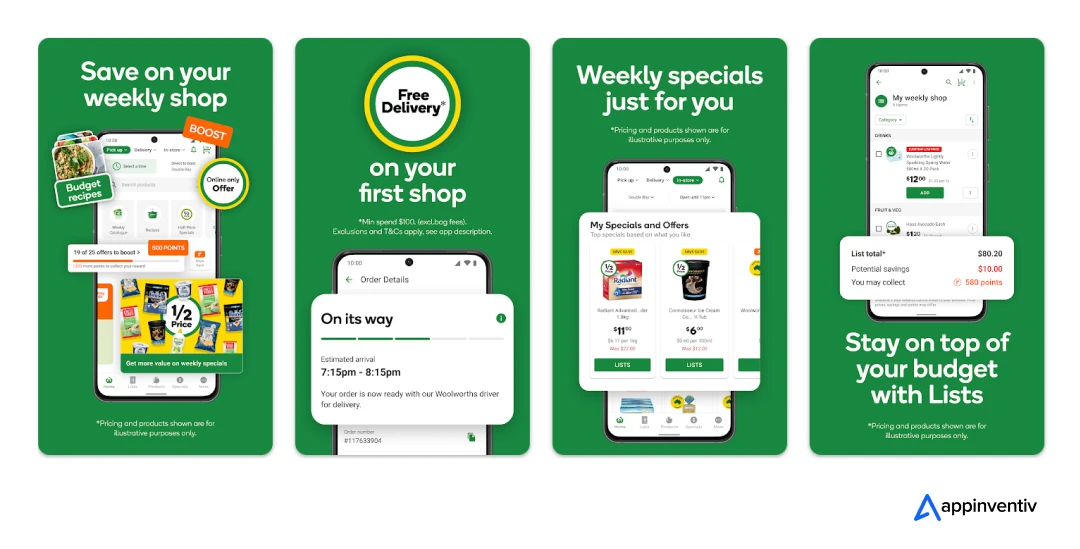
With 1 million+ downloads and thousands of positive reviews, the app has clearly resonated with consumers, establishing itself as a trusted and preferred choice for convenient online shopping. Furthermore, the overall design of the app is user-friendly, making it easy for shoppers to browse categories, find products, and check out quickly. This efficiency is a big plus for customers who value their time and prefer fast shopping solutions instead of traditional in-store visits.
The inclusion of features like order tracking and scheduled deliveries further lets the customers get their groceries when it works best for them. This coordination makes shopping smoother and boosts operational efficiency by cutting down on wait times and improving delivery routes.
According to the reports, the eCommerce sales of the platform reached around $3.95 billion in 2023 and now accounts for 11.4% of the brand’s net sales. The reports further suggest that the sales are expected to grow based on the relative performance of the platforms as well as the increasing digital traffic.
According to the brand’s CEO, the on-demand retail giant was able to stay on their strategic agenda and witness all these amazing milestones by strengthening their retail platforms with the integration of technologies like advanced analytics, digital and media, ecommerce fulfillment, loyalty, and supply chain.
Now, in a market where convenience is king, the Woolworth app’s underlying model shows how integrating technology with traditional retail can create a powerful platform that meets modern consumer demands. This strategy not only improves customer interaction but also raises the bar for operational efficiency, making it a great model for businesses aiming to innovate and expand in the retail sector.
Also Read: On Demand Services Mobile App: Beneficial for Both Buyers and Sellers
Now that you have a small idea into the benefits of Woolworths-like retail app development, let’s look at the factors affecting woolworths-like app development cost in detail below.
Factors Affecting the Cost to Build a Retail Delivery App Like Woolworths
Several factors play a critical role in determining the overall cost when considering the development of an on-demand retail delivery app like Woolworths. These variables can significantly influence both the initial and ongoing financial commitments required to launch such a platform.
 App Complexity and Feature Set
App Complexity and Feature Set
The more complex the app, the higher the cost to build a retail delivery app like Woolworths. Features like real-time AI-based inventory management, AI-based product recommendations, and integrated loyalty programs require sophisticated coding and testing, which can increase development time and expense.
Platform Compatibility
Developing an app that functions seamlessly across multiple platforms like iOS, Android or Web can also drive up the overall on-demand retail delivery app development cost. Each platform may have different requirements and complexities, especially when ensuring a consistent user experience.
UI/UX Design
Good UI/UX design is crucial to build a retail app like Woolworths that’s both visually appealing and easy to navigate. It involves hiring skilled designers and conducting extensive user research, which can increase development costs. However, this investment is vital as it directly influences user satisfaction and retention, impacting the app’s overall success and lifecycle costs.
Backend Infrastructure
The strength of the app’s backend infrastructure is essential for managing data processing, storage, and security effectively. Investing in robust servers and secure, scalable cloud services is crucial to ensure the app can handle varying loads and protect user data from breaches. While these components are critical for the app’s performance and reliability, they do add to the initial cost to build a retail delivery app like Woolworths.
Integration with Existing Systems
Integrating the new app with existing inventory, CRM, or ERP systems can be complex and costly, depending on the compatibility and architecture of the current systems.
Ongoing maintenance costs, which cover bug fixes, updates, and adding new features, are important for keeping the app up-to-date and running smoothly. These costs depend on how the app is built and how often you plan to update it. Keeping the app maintained helps ensure it stays useful and attractive to users. To sum up, maintenance costs also add to the overall on-demand retail delivery app development cost.
Regulatory Compliance
Compliance with data protection regulations, payment processing standards, and other legal requirements is crucial and can add to the overall cost to build a retail delivery app like Woolworths. For an app like Woolworths or similar on-demand delivery services, businesses need to comply with the Australian Privacy Principles (APPs) under the Privacy Act 1988, which governs how personal information must be handled and protected.
Location of Development Team
The location of your app development team can greatly affect the on-demand retail delivery app development cost. For example, developers in countries like the UK or Australia generally charge higher hourly rates compared to those in Asia. If businesses want to develop robust apps at an optimized rate but still meet quality and compliance standards, they might consider outsourcing to a dedicated firm in India. They have the capability to offer expert services while ensuring that the app complies with necessary regulations.
| Region | Hourly Rates of Development |
|---|---|
| UAE | $60-$65 |
| US | $95-$100 |
| Western Europe | $80-$90 |
| Australia | $70-$90 |
| Eastern Europe | $50-$55 |
| Asia | $25-$40 |
Now that you have a gist of the major factors that affect the on-demand retail delivery app development cost, let’s look at the major user-side and driver-side features that must be integrated in a retail app like Woolworths.
Features to Develop a Robust On-Demand Retail Delivery App Like Woolworth
Creating an on-demand retail delivery app like Woolworths requires integrating a variety of features that enhance user experience and operational efficiency. Let’s look at on-demand retail delivery app features in detail:
User-Side Features of an On-demand Retail App Like Woolworths
User Registration and Profile Management
Allow users to register and create profiles where they can manage their information, preferences, and payment options. This personalized approach helps in delivering a customized shopping experience.
Product Browsing and Search Functionality
Implement an easy-to-navigate product catalog with detailed descriptions, high-quality images, and advanced search filters. This lets users effortlessly find the items they need or discover new products.
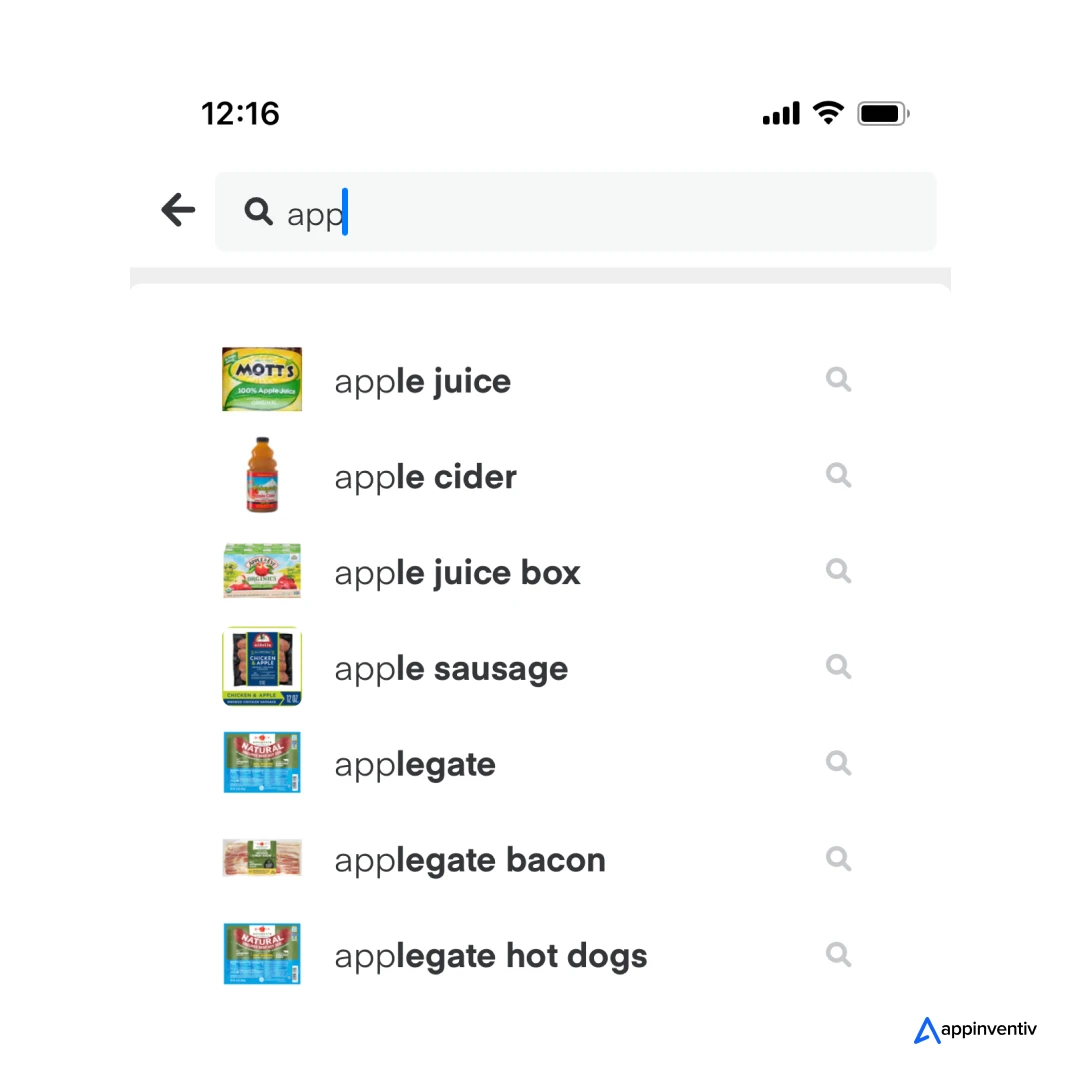
Shopping Cart and Checkout System
The app should feature an intuitive shopping cart that streamlines the checkout process. Users can easily add items to their cart and proceed to checkout, where they are offered multiple payment options, including credit cards, digital wallets, and cash on delivery.
Recipes and Ideas
Integrating a feature that offers recipes and meal ideas can significantly enhance the user experience. By providing inspirational content directly related to the products available in the app, you encourage users to try new products and increase their purchase frequency.
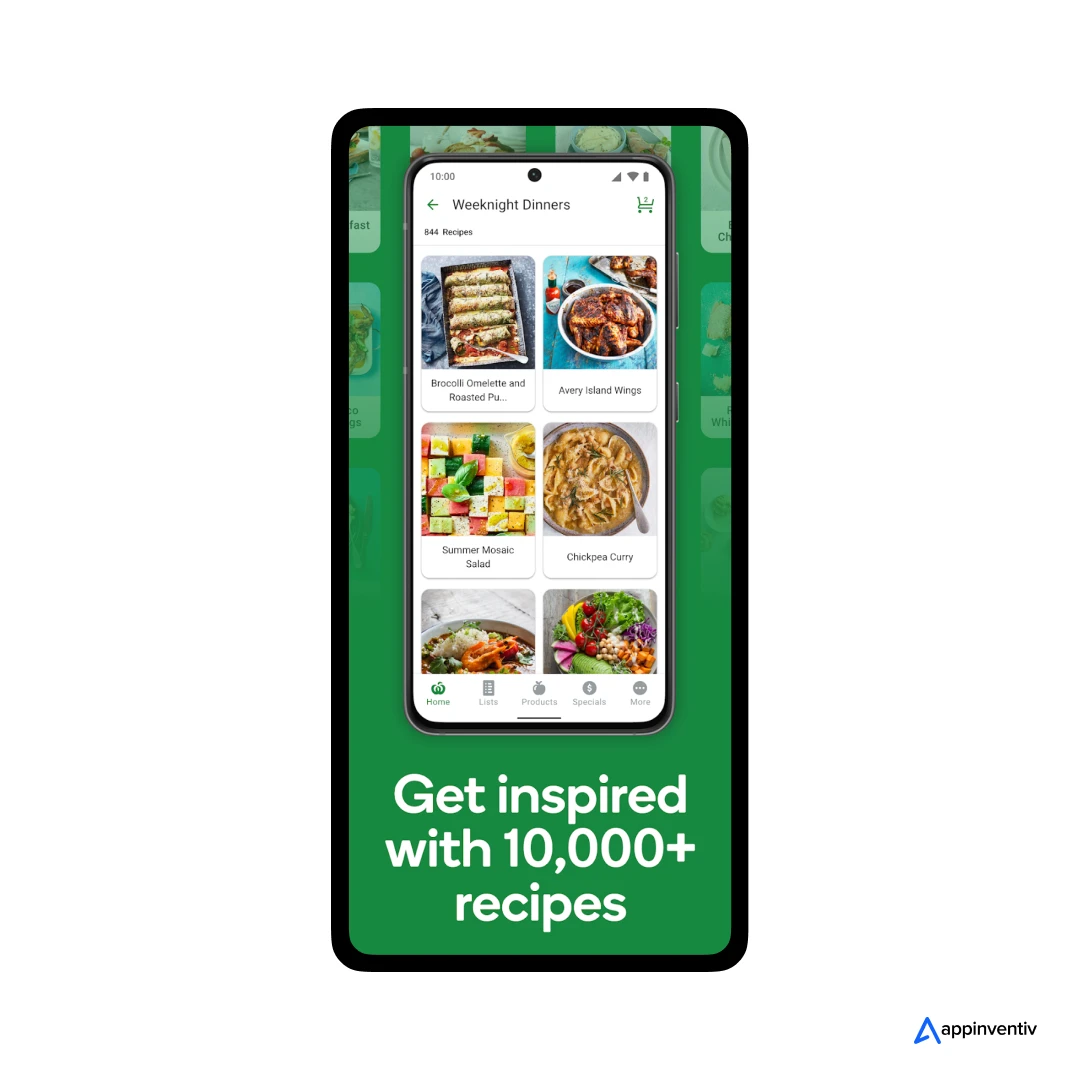
Real-Time Inventory Updates
This keeps your users informed with real-time updates on product availability. Understanding that this feature requires robust backend integration with your supply chain is vital.
Order Tracking and Scheduling
Users can track their orders in real-time and schedule deliveries when it suits them best. Furthermore, they can checkout the estimated delivery times and get regular updates throughout the delivery process.
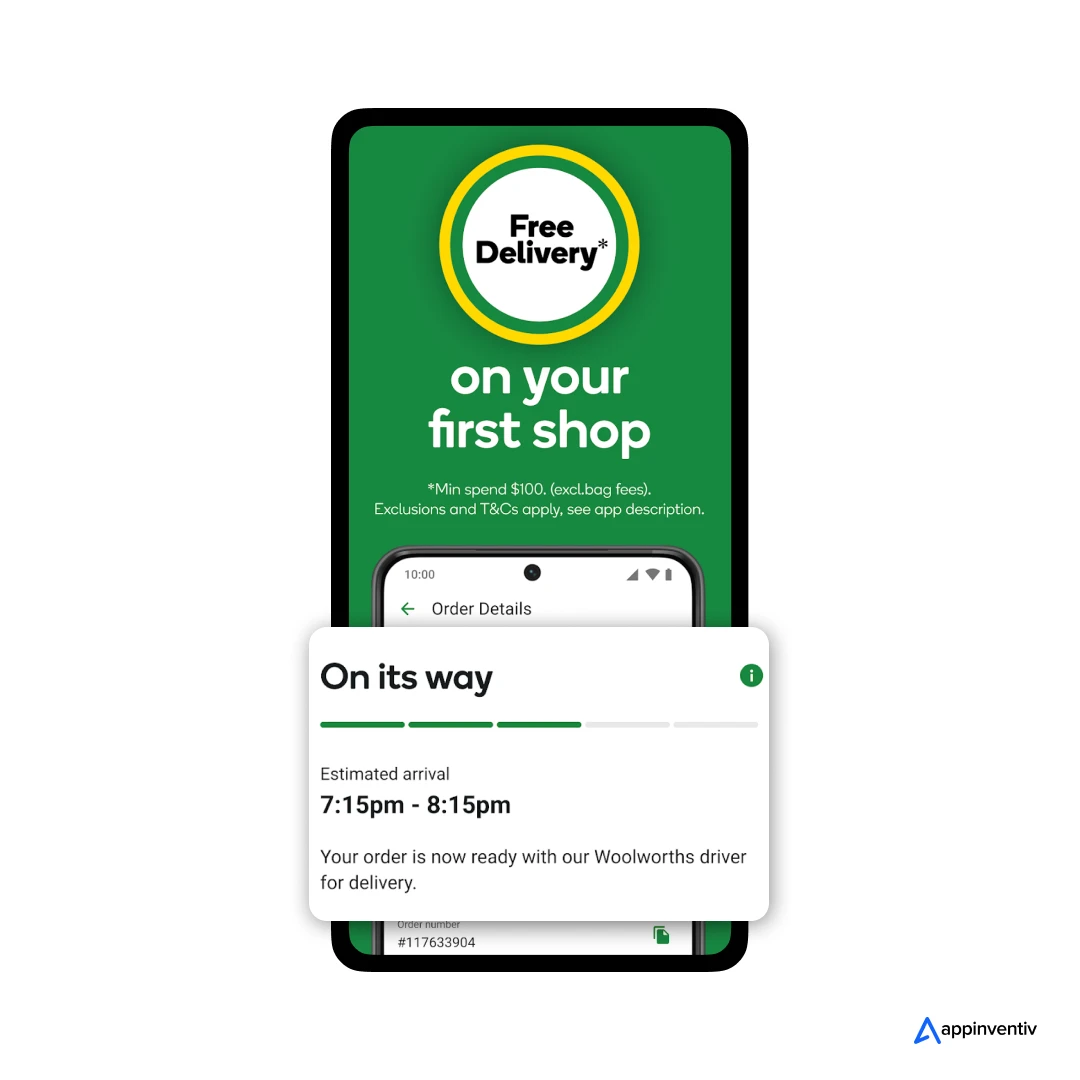
Push Notifications
Use push notifications to keep users informed about new products, special offers, and order status updates. This feature helps keep users engaged and informed.
Feedback and Ratings
Users can rate and review products and services, which aids other customers in making informed decisions and provides valuable feedback for improving the app.
Customer Support
The app offers easy access to customer support through in-app chat, phone, and email. This helps to resolve any issues or questions quickly, thereby building user trust and satisfaction.
Everyday Rewards
Incorporate a loyalty program that rewards users for their purchases. This feature could offer points for each dollar spent, which can be redeemed for discounts, special offers, or exclusive access to new products.
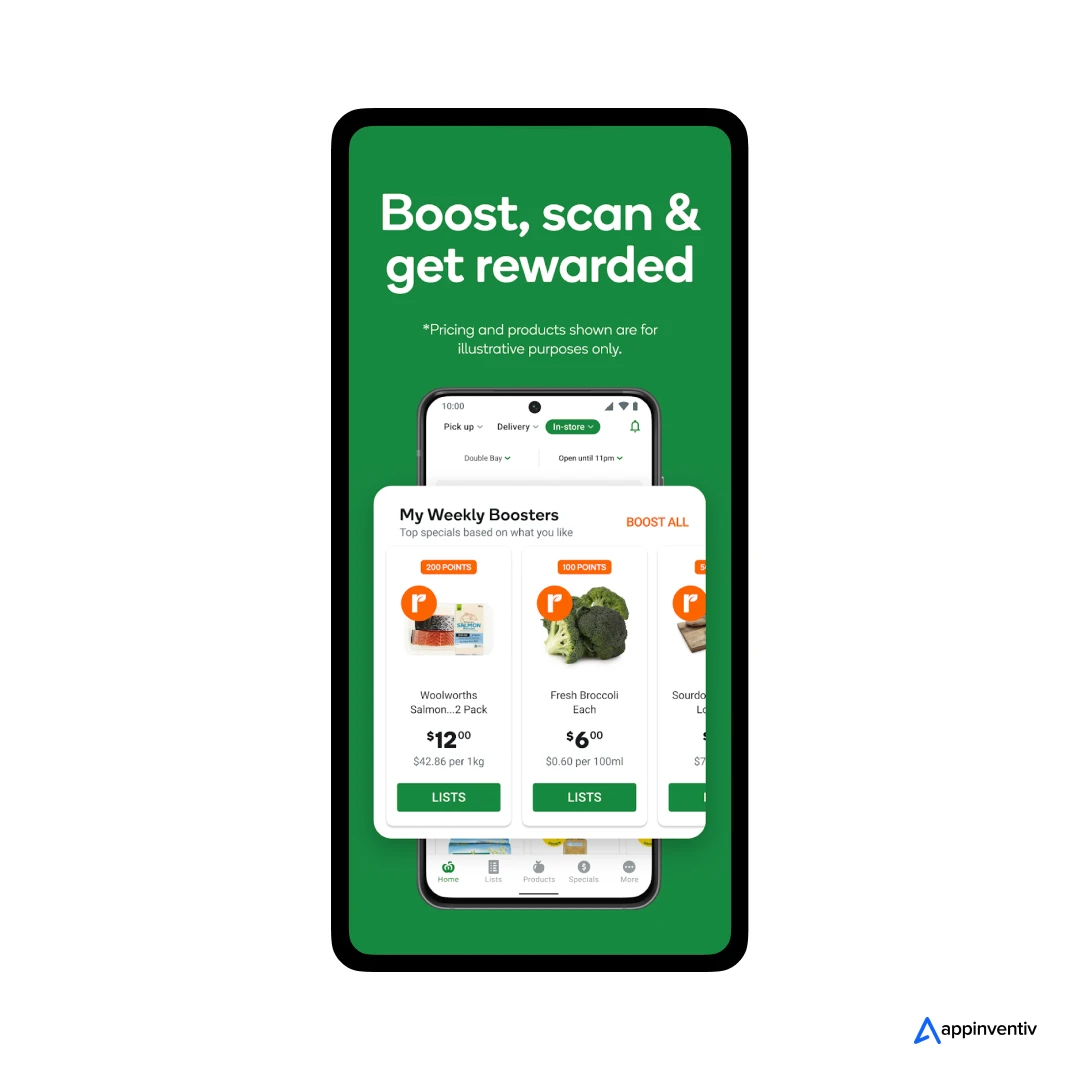
Advanced Analytics
The app should include integrated analytics tools for business owners to track sales, customer behavior, and inventory that can help them make informed decisions. This also helps in optimizing operations and marketing strategies. It is vital to understand that implementing these kinds of advanced features can also impact the overall on-demand retail delivery app development cost.
Delivery Agent-Side Features of an On-Demand Retail App Like Woolworths
Creating a robust on-demand retail delivery app like Woolworths requires integrating features that cater to consumer needs and streamline operations for the delivery agents. Let’s look at them below:
Driver Profile
Drivers have their own profiles where they can manage personal information, track their deliveries, earnings, and work schedule.
Route Optimization
The app should offer drivers optimized delivery routes using real-time traffic data and delivery locations to suggest the quickest and most efficient paths, saving time and fuel.
Also Read: Route Planner App Development – Costs, Benefits, Features
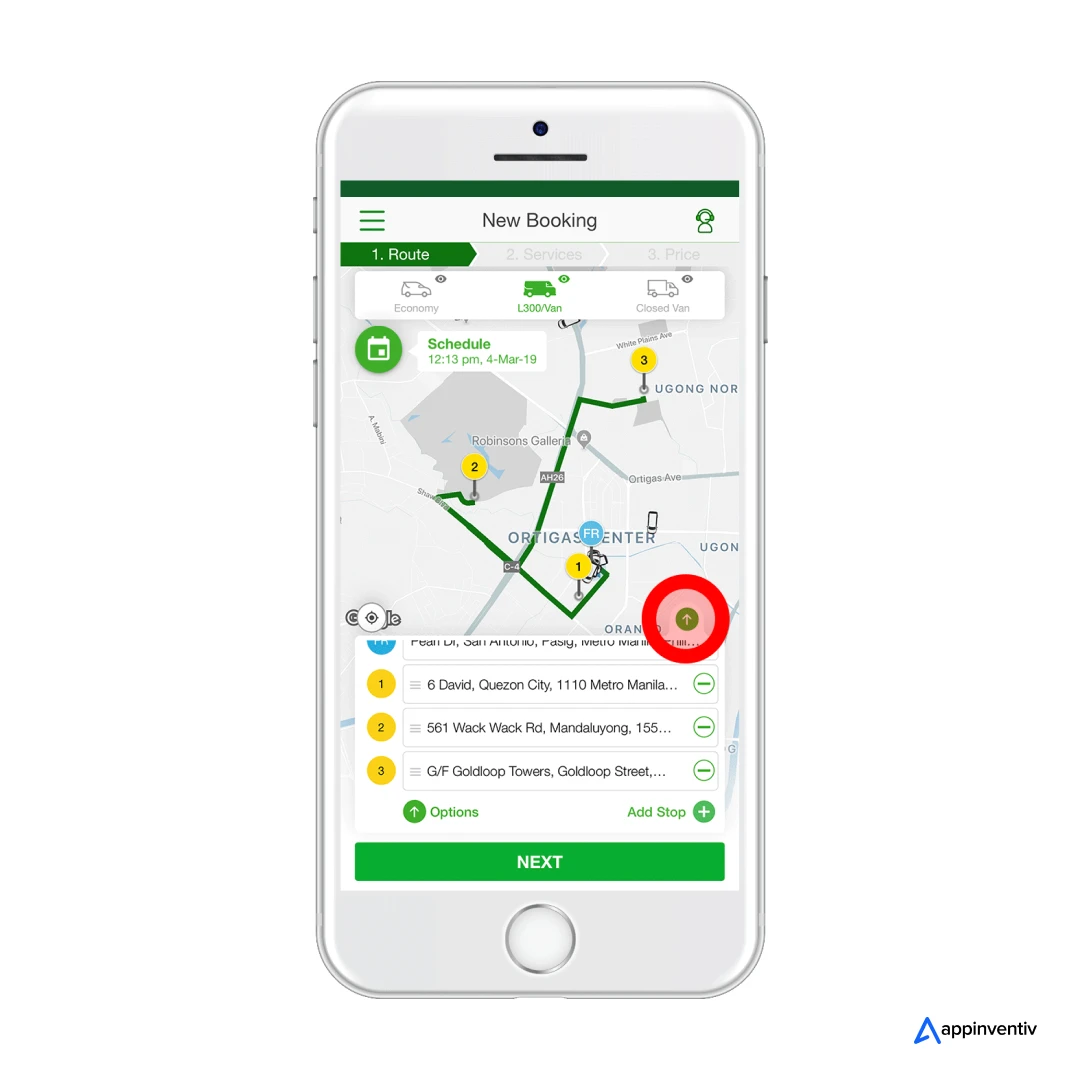
Delivery Scheduling
Drivers can view and manage their delivery schedules in the app, including pickup and drop-off locations, time slots, and customer instructions. This ensures deliveries run smoothly and are on time.
Real-Time Communication
The app should facilitate real-time communication between drivers, customers, and support teams, allowing for immediate adjustments. This improves the overall delivery experience. Incorporating such features also add to the overall retail delivery app development cost like Woolworths but are necessary for a seamless product delivery.
Earnings Tracker and Reporting
Drivers should be able to track their earnings, tips, and bonuses live through the app. In addition to this, they should be able to generate reports for different time frames. This features aids in overall financial planning and record-keeping.
Incident Reporting
Drivers can report incidents or issues, such as vehicle problems or safety concerns, directly through the app. This allows for quick responses to address challenges.
Admin-Side Features of a Retail Delivery App Like Woolworths
Admin features in a retail delivery app like Woolworths are crucial for maintaining smooth operations, monitoring activities, and ensuring efficiency across all aspects of the delivery process. Let us look at them in detail below:
Dashboard
The dashboard offers admins a quick overview of ongoing operations, including current delivery statuses, earnings, and performance metrics. This centralized view helps admins monitor activities and make decisions quickly.
Order Management
Admins have the ability to view and control all orders in real-time. They can assign orders to drivers, track the status of deliveries, and handle any issues that might come up during the delivery process.
Driver Management
This feature allows admins to add, delete, or modify driver profiles. It also includes tracking driver performance, scheduling shifts, and managing payments to ensure efficient operations.
Customer Support Interface
This helps admins quickly resolve customer queries and issues, maintaining high customer satisfaction. It ensures all customer feedback and problems are addressed effectively.
Analytics and Reporting
Admins can use analytics tools to gain insights into business operations, customer habits, and financial performance.
Now that you have looked into multiple factors that affect the cost to build a retail delivery app like Woolworths as well as the multiple Woolworths app features, let’s move ahead and look at the Woolworths app development process in detail below.
How to Develop an App Like Woolworths?
Developing an app like Woolworths involves several key steps, each critical to creating a successful on-demand retail delivery platform. Here’s a step-by-step guide to create a retail delivery app like Woolworths that can effectively compete in the crowded market of retail delivery.
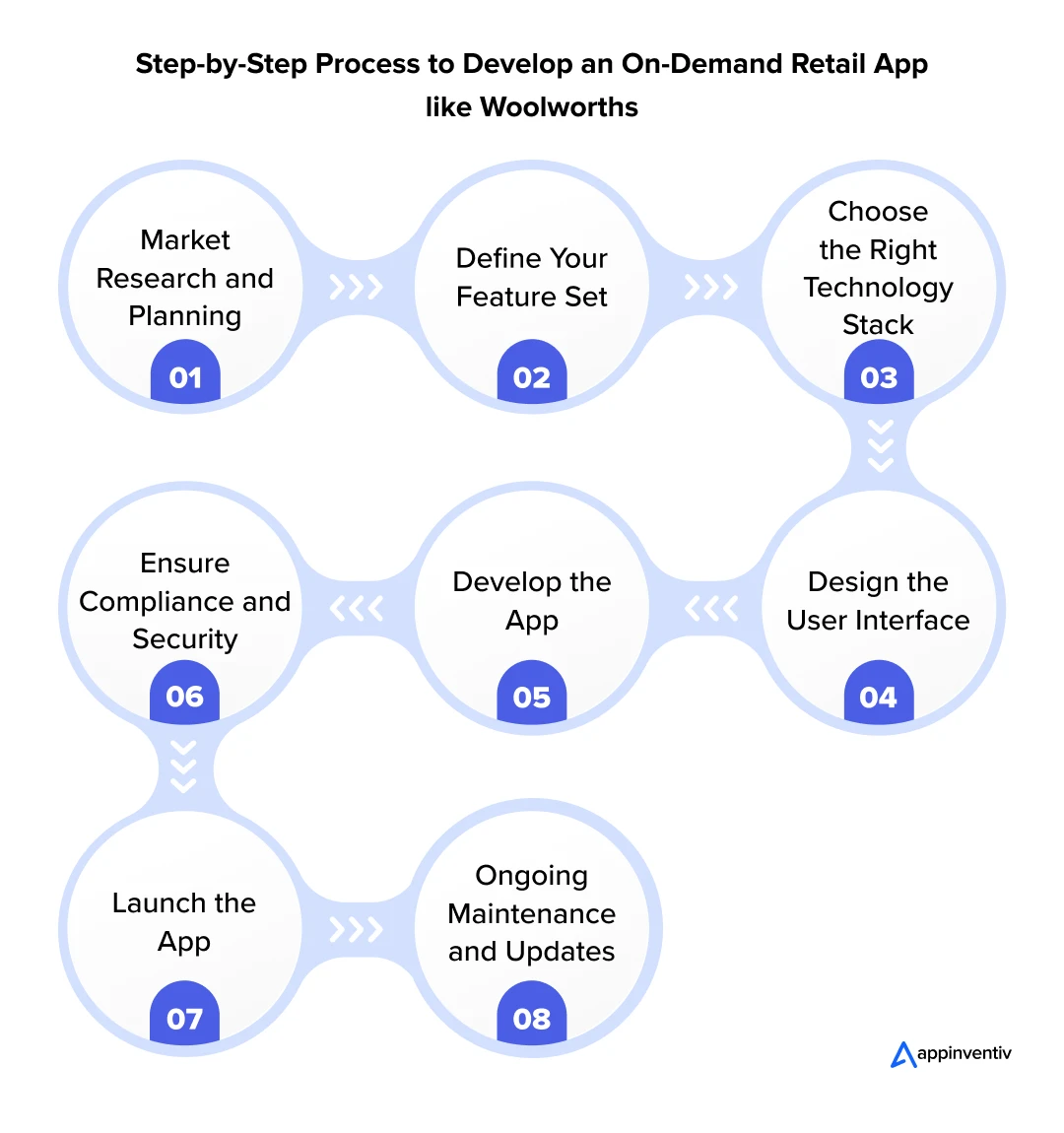
Market Research and Planning
Begin the on-demand retail delivery app process by conducting detailed market research to understand your target audience, their needs, and the competitive landscape. Identify market gaps that your app could fill. This stage should also involve defining your app’s scope, setting clear goals, and planning the unique features that will set your app apart from competitors.
Define Your Feature Set
Choose the essential features your app needs, such as user registration, product browsing, shopping cart, order tracking, and customer support. Consider adding special features that improve the user experience, like personalized recommendations or loyalty programs, and prioritize these based on what your users need and your business goals.
Choose the Right Technology Stack
Picking the right technology stack is key to creating a retail delivery app like Woolworths that gets millions of users. This choice should include programming languages, databases, and frameworks that fit your app’s needs well. Think about factors like how well the technology can handle loads, its security features, and how easily it integrates with other systems.
Design the User Interface
Work on creating a user interface that is intuitive and visually pleasing. Good UI/UX design is crucial to keep users engaged and ensure they can navigate your app easily. The design should be user-friendly, visually appealing, and follow the latest design trends.
Develop the App
Proceed with the actual development of the app. This phase includes both front-end and backend development, integrating APIs, and extensive testing to ensure everything works perfectly together. Make sure your app performs well and is bug-free.
Ensure Compliance and Security
During the on-demand retail delivery app process, ensure your app meets all relevant legal and regulatory standards concerning data protection and payment security. Put strong security measures in place to safeguard user data and secure transaction information.
Launch the App
Once your app is ready and tested, deploy the app in the required environment. After launching, gather user feedback to find areas for improvement.
Ongoing Maintenance and Updates
Continue to support the app by regularly adding new features, fixing bugs, and enhancing existing functionalities. Monitor user feedback and analytics to continuously adapt and improve the app based on user needs and technological changes.
How Appinventiv is the Right Partner for Developing a Retail Delivery App like Woolworths
Considering all the intricacies that go into developing an on-demand retail delivery app like Woolworths, it is vital for businesses to partner with the right development firm that can help them successfully map out the journey from conception to launch.
As a reputed retail software development company, we have a deeper understanding of market dynamics and consumer behavior. Also, our experts are well-experienced and, equipped to deliver tailored solutions that not only meet but exceed your business requirements.
By leveraging cutting-edge technologies and robust development methodologies, our experts ensure that your app is scalable, secure, and capable of delivering a seamless user experience.
As a dedicated on-demand app development company, we have successfully collaborated with various global clients in the retail sector, providing them with apps that not only increase their operational efficiency but also significantly enhance user engagement and satisfaction. Our portfolio includes collaborations with industry giants, showcasing our ability to handle complex projects and deliver exceptional results.
For instance, our collaboration with Y.K. Almoayyed & Sons in order to develop a retail and distribution platform on cloud turned out to be a hit, resulting in a revamped infrastructure for the brand that has enhanced their operational capacities as well as fortified their data security.
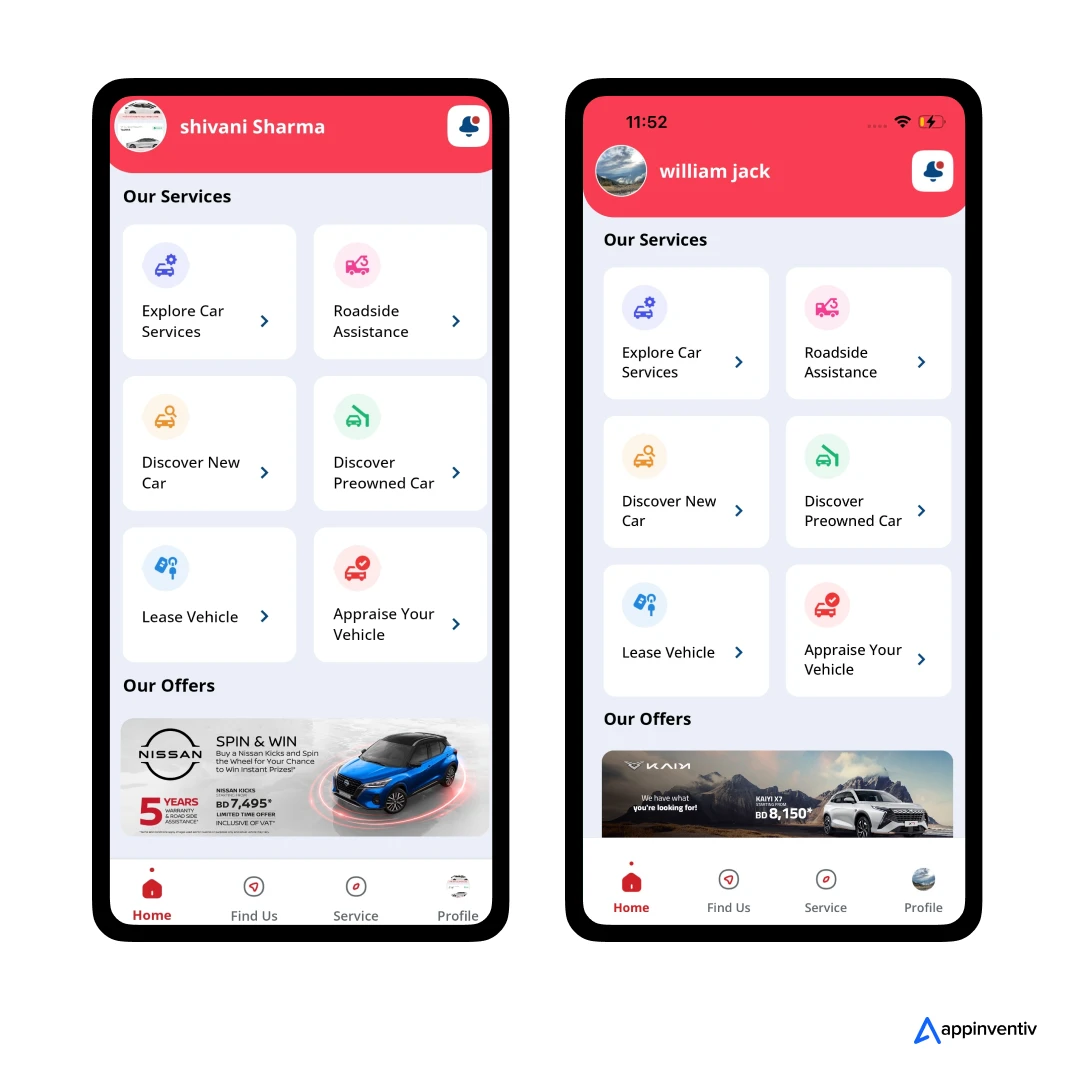
In addition to this, we also collaborated with world’s largest furniture retailer IKEA in developing an ERP system for them that now helps them in offering their customers an in-store catalog while also helping as a promotional asset for marketing purposes.
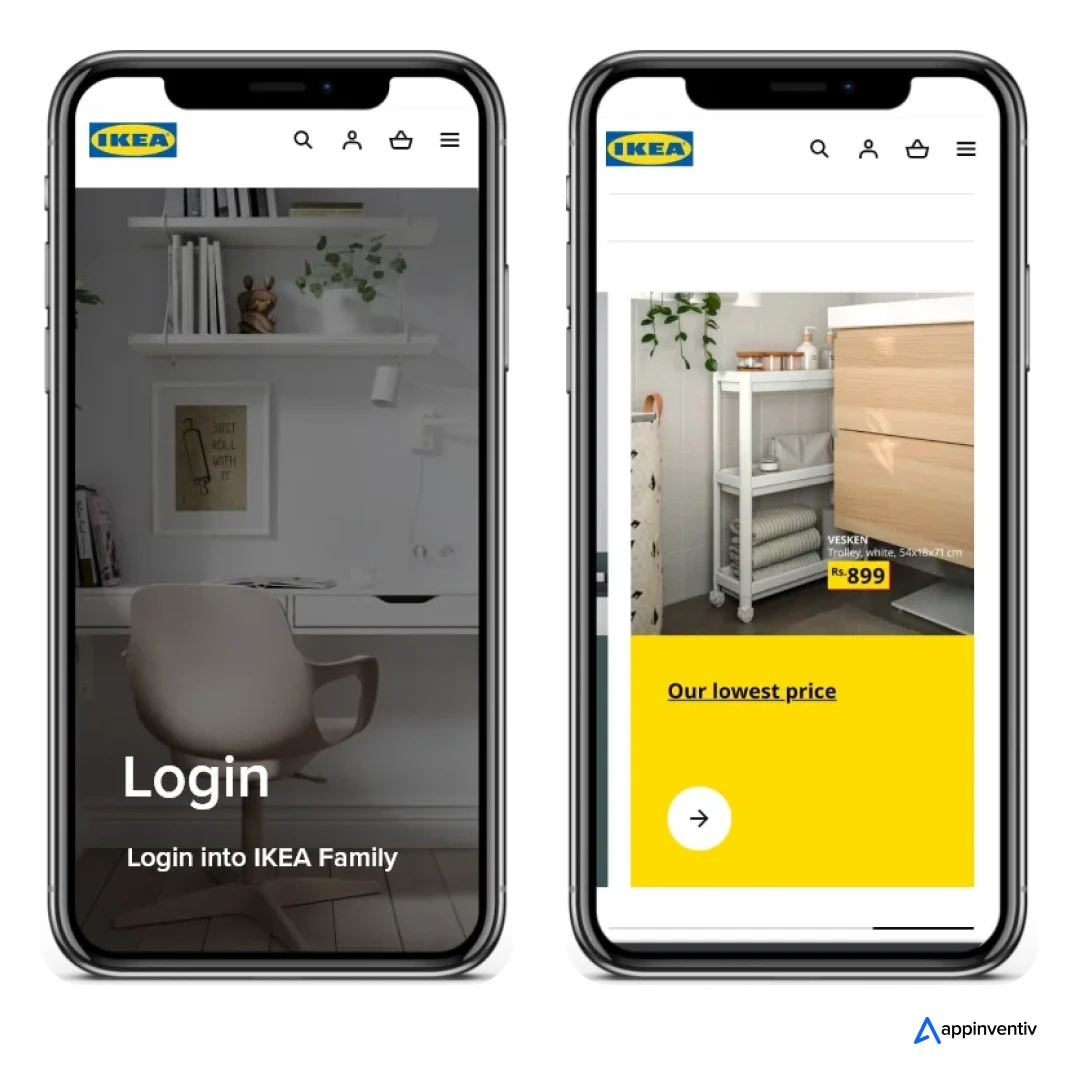
Our collaboration with the world’s greatest sports merchandise retailer Adidas helped the brand revamp its digital presence globally. The app was able to 2M+ down;oads while acquiring over 500k new users.
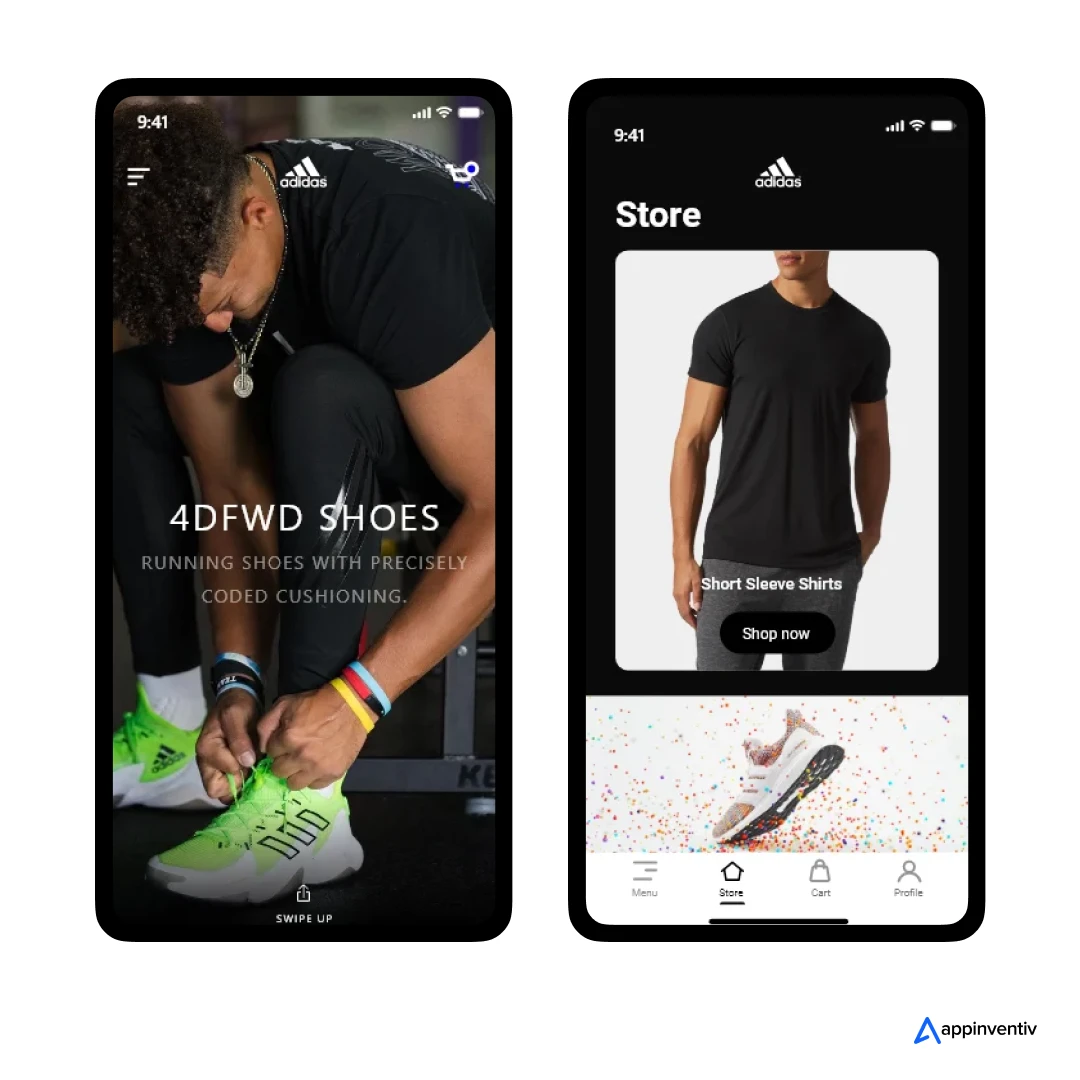
Get in touch with our experts to leverage not only our technical expertise but also our strategic understanding of the retail landscape, ensuring that your app meets today’s needs and is prepared for future growth.
FAQs
Q. How much does it cost to develop an online retail app like Woolworths?
A. The cost to build a retail delivery app like Woolworths can vary from $40,000 to $200,000. There are multiple factors that impact the overall cost of development such as the app’s complexity, the features integrated, the technology used, and the location of the development team. Additional features like real-time tracking, personalized recommendations, and advanced security measures can also affect the overall price to make a retail app like Woolworths.
Q. How long does it take to develop an app like Woolworths?
A. Developing an app like Woolworths generally takes between 12 to 14 months. The exact timeline depends on the app’s complexity, the number of features required, and the efficiency of the development process. Other activities like market research, planning, and design also play a significant role in determining the overall development duration.
Q. How to develop an on-demand grocery delivery app like Woolworths?
A. To make a retail app like Woolworths, start with thorough market research to understand user needs and industry trends. Next, define your app’s feature set, including essential components like user registration, product browsing, payment integration, and order tracking. Choose a suitable technology stack that ensures scalability and security.
Design a user-friendly UI/UX to enhance customer experience and then proceed with the development phase, focusing on robust backend architecture and seamless front-end integration. Ensure compliance with legal and security standards. Finally, plan a strategic launch followed by ongoing maintenance and updates to keep the app competitive and up-to-date.



How Much Does It Cost to Build an On-demand Alcohol Delivery App Like Gopuff?
The global online alcohol market is experiencing significant expansion, akin to a premium vintage reaching its peak maturity. With just a few clicks, consumers can access a diverse selection of fine wines, craft beers, premium spirits, and services, all conveniently delivered to their doorstep. This digital transformation in alcohol sales has been driven by the…

How Much Does It Cost to Build a Service Delivery App Like Airtasker?
On-demand apps have exploded in popularity globally due to their unparalleled convenience and seamless user experience. Consumers crave instant gratification, and these apps provide it by offering a vast array of services readily accessible through a smartphone. From food delivery and transportation to cleaning and handyman services, everything is just a few taps away with…
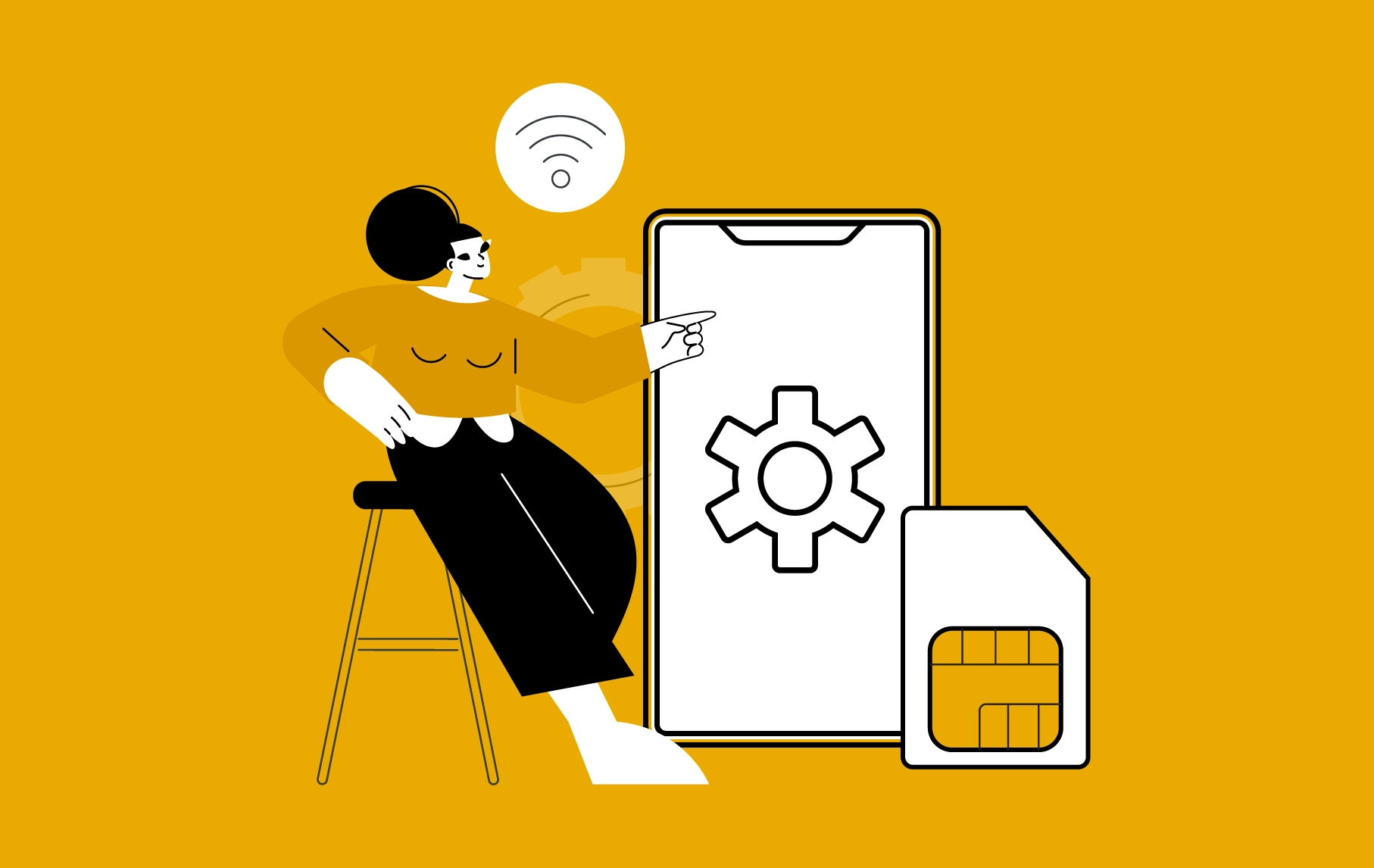
How Much Does It Cost to Build an eSIM App like Airalo and Holafly?
In today's net-savvy world, where seamless global communication is non-negotiable, eSIM (embedded SIM) apps have emerged as the game-changers, revolutionizing how we connect and communicate, particularly in the realm of international travel. These applications promise travelers an unprecedented level of flexibility and convenience, making international adventures smoother and more enjoyable. An eSIM operates as a…


















